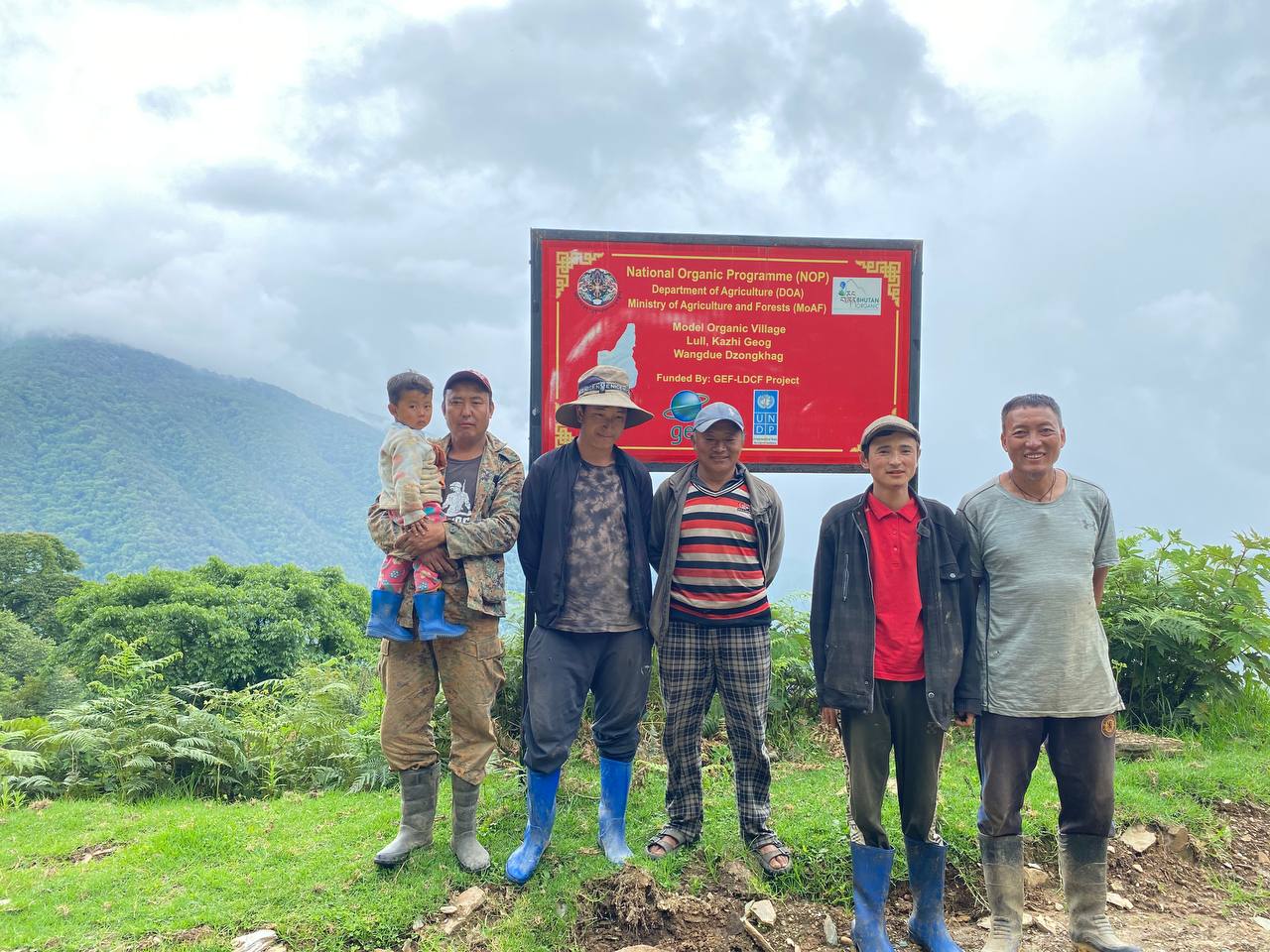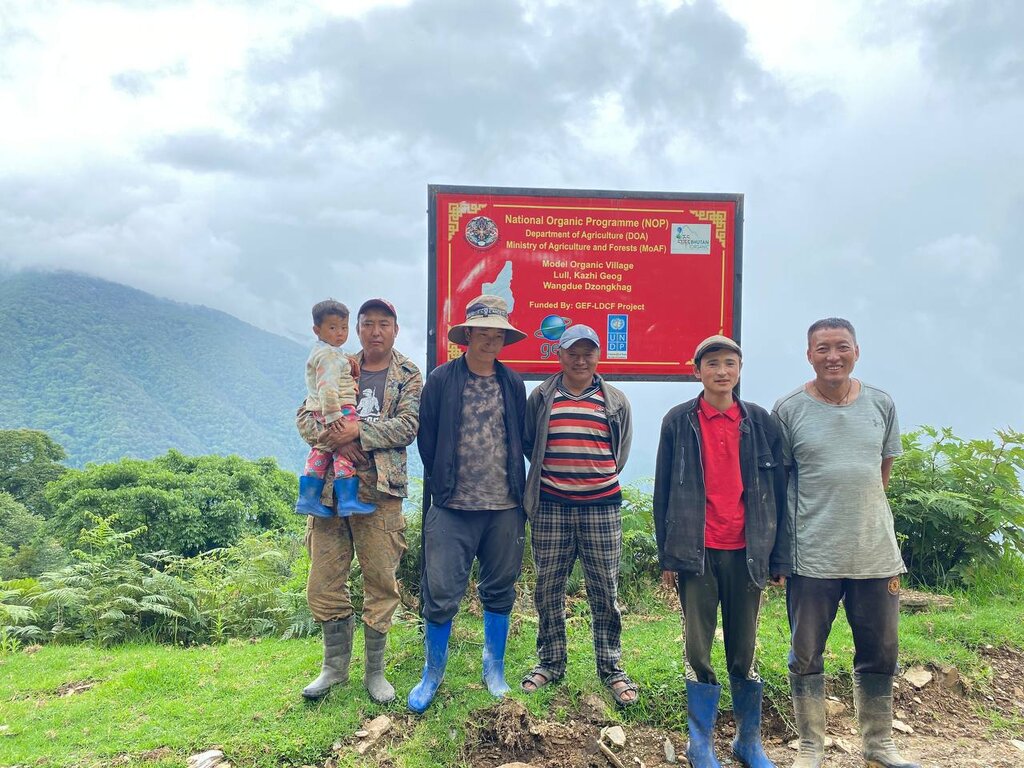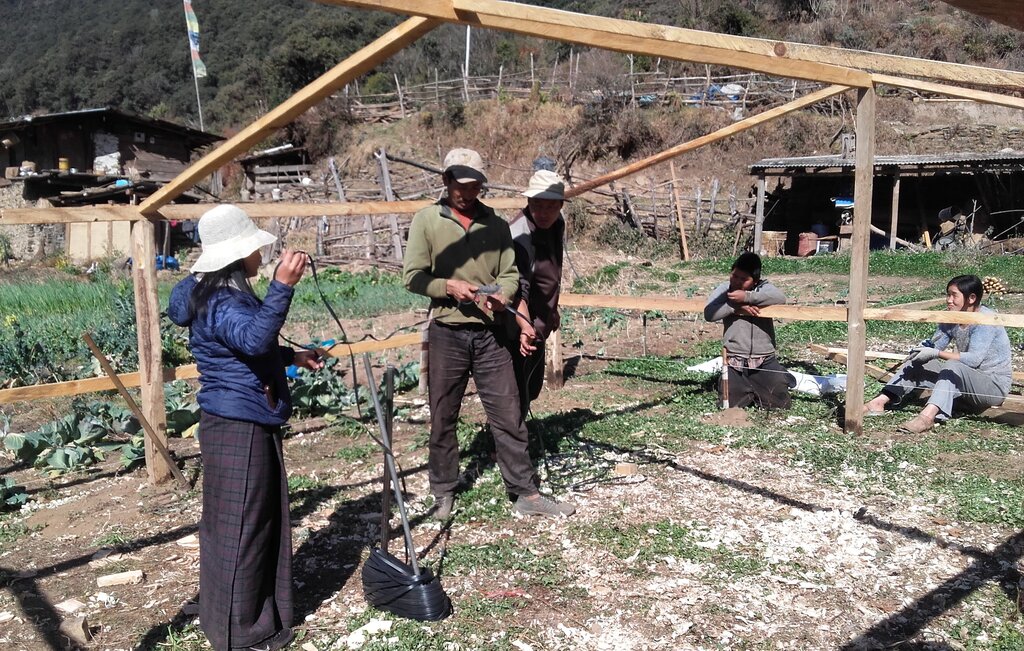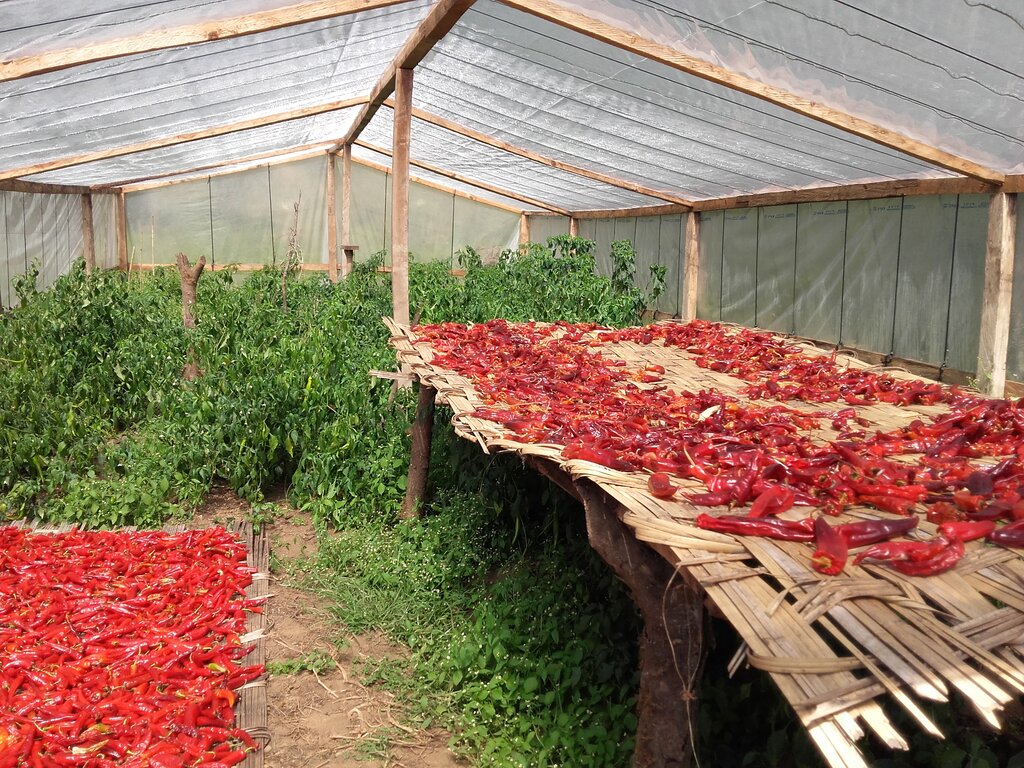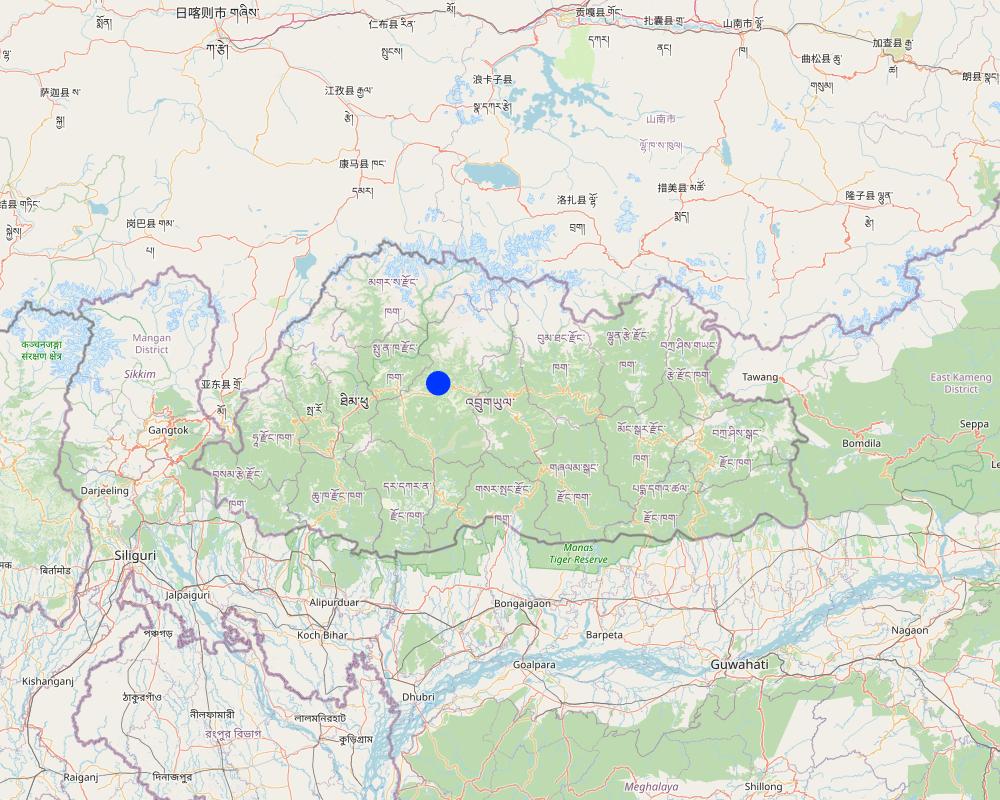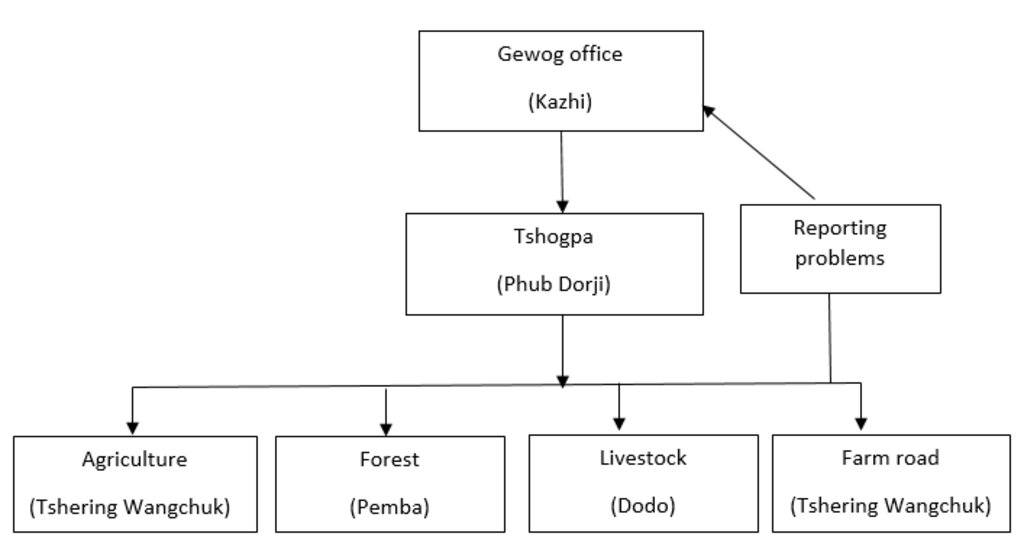Model Village Approach to Scaling Out Organic Agriculture [Bhutan]
- Creation:
- Update:
- Compiler: Karma Wangdi
- Editor: chenga Tshering
- Reviewers: William Critchley, Rima Mekdaschi Studer
Petoen Yue gi Thogley Rangzhin Sanam Jakaed Tangthab (དཔེ་སྟོན་གཡུས་ཀྱི་ཐོག་ལས་རང་བཞིན་སོ་ནམ་བརྒྱ་བསྐྱེད་བཏང་ཐབས།)
approaches_6838 - Bhutan
View sections
Expand all Collapse all1. General information
1.2 Contact details of resource persons and institutions involved in the assessment and documentation of the Approach
Key resource person(s)
land user:
Pemba
17738919
Lull Village, Lengbi Chiwog
Lull village, Lengbi Chiwog Community), Kazhi Gewog (Block), Wangduephodrang Dzongkhag (District)
Bhutan
land user:
Dorji Phub
77330501
Lull Village, Lengbi Chiwog, Kazhi Geog, Wangdue Phodrang
Lull Village, Lengbi Chiwog, Kazhi Gewog, Wangdue Phodrang.
Bhutan
land user:
Dodo
17473224
Lull Village, Lengbi Chiwog (Block), Kazhi Gewog (Block), Wangduephodrang Dzongkhag (District)
Lull Village, Lengbi Chiwog, Kazhi Gewog, Wangdue Phodrang.
Bhutan
land user:
Wangchuk Tshering
17160021
Lull Village, Lengbi Chiwog, Kazhi Gewog, Wangduephodrang
Lull Village, Lengbi Chiwog, Kazhi Gewog, Wangduephodrang.
land user:
Wangchuk Tshering
17443965
Lull Village, Lengbi Chiwog, Kazhi Geog, Wangduephodrang
Lull Village, Lengbi Chiwog, Kazhi Gewog, Wangduephodrang.
Bhutan
Name of project which facilitated the documentation/ evaluation of the Approach (if relevant)
Strengthening national-level institutional and professional capacities of country Parties towards enhanced UNCCD monitoring and reporting – GEF 7 EA Umbrella II (GEF 7 UNCCD Enabling Activities_Umbrella II)Name of the institution(s) which facilitated the documentation/ evaluation of the Approach (if relevant)
National Soil Services Centre, Department of Agriculture, Ministry of Agriculture & Livestock (NSSC) - Bhutan1.3 Conditions regarding the use of data documented through WOCAT
When were the data compiled (in the field)?
10/07/2023
The compiler and key resource person(s) accept the conditions regarding the use of data documented through WOCAT:
Ja
2. Description of the SLM Approach
2.1 Short description of the Approach
Organic agriculture includes a variety of farming systems that advance the sustainable production of food and fibres, prioritizing human health, and environmental, social, and economic aspects. The main objective of the model village approach is to promote the commercialization of organic farm produce.
2.2 Detailed description of the Approach
Detailed description of the Approach:
Organic farming is a system of agricultural production based on the use of natural processes and resources. Organic farming is on the rise worldwide. Until 1961, when chemicals were introduced to Bhutanese farmers, Bhutan was 100% organic. There were no chemicals to buy and no chemicals to use. There were no genetically modified seeds to buy and no genetically modified seeds to use. Farmers were required to weed their field by hands instead of spraying butachlor, a powerful pesticide used in paddy fields. According to Dzongkhag agriculture officer (DAO), a farmer in Wangdue, said that organic agriculture is "what we used to do." Traditional farming methods in Bhutan are organic and the departure from that has been a recent movement. But young farmers who started after the introduction of chemicals cannot remember a time when chemicals were not a part of their farming practices. The increase in chemicals is a recent trend, and depending on which chemical is under consideration the trend has either stagnated or grown. According to the national organic program, the use of fertilizer has remained constant over the last thirty years. On the other hand, the use of synthetic herbicides has grown each year. The primary example of herbicides used are butachlor in rice paddy fields and metribeuzin in potatoes (Hokenson, 2014).
The Department of Agriculture in collaboration with Dzongkhag Agriculture Office and Gewog Administration identified Lull village, Lengbi Chiwog of Kazhi gewog as a "Model Organic Village" to improve the livelihoods of people through crop diversification and income generation. Lull village was identified as an organic village in 2018. The main objective of this approach is to promote the commercialization of organic farm produce through post-production and value addition (Dorji, 2022).
In 2013, 51-year-old Tashi Bidha was the only farmer in Lull, a village situated in the Kazhi gewog region, approximately 40 kilometers from Bajo, Wangdue. The village, comprising a mere eight households, was classified as one of the most isolated in the Wangdue region. Lull is presently the first prosperous organic village in Wangdue. This began in 2013 with the initiative of one individual to establish road connectivity. Phub Dorji, a native of Lull, remarked that the village lacked roads and electricity at the time.
The village's application for road connectivity was rejected in 2013 due to its failure to satisfy the minimum threshold of 20 households. Many were apprehensive when Phub Dorji suggested that they make their own road. Following some deliberation, however, six households reached a consensus. Six households contributed more than Nu.500,000 towards the repair of the 8.8 kilometers of road in Lull. Electricity arrived in the village months after the road was constructed. The community consented to transition to organic practices in 2017.
Wangdue’s agriculture extension stated the village received potato seeds, asparagus seedlings, bio-fertiliser, bio-pesticide and vermicomposting among others. The village has five polyhouses, and they have first-hand training in bio-pesticide preparation. They are now technically equipped. Lull previously cultivated wheat, barley, and chili. The village currently produces more than eleven different types of commodities and distributes its goods in Phuentsholing, Thimphu, Punakha, and Wangdue. Potatoes, garlic, and chili peppers are among the principal cash commodities of Lull. Presently, income generation has increased to Nu 770,000 since the transition to organic practices.
2.3 Photos of the Approach
2.5 Country/ region/ locations where the Approach has been applied
Country:
Bhutan
Region/ State/ Province:
Wangdue phodrang
Further specification of location:
Kazhi, Lull village
Map
×2.6 Dates of initiation and termination of the Approach
If precise year is not known, indicate approximate date when the Approach was initiated:
less than 10 years ago (recently)
2.7 Type of Approach
- recent local initiative/ innovative
2.8 Main aims/ objectives of the Approach
To improve the livelihoods of people by through crop diversification and income generation while promoting the commercialization of organic farming through post-production and value-addition for independency and self sufficiency.
2.9 Conditions enabling or hindering implementation of the Technology/ Technologies applied under the Approach
social/ cultural/ religious norms and values
- enabling
Able to conserve biodiversity and nature resources on farm and in the surrounding environment.
availability/ access to financial resources and services
- enabling
Increasing income and reducing production cost
collaboration/ coordination of actors
- enabling
Integration of traditional knowledge, joint problem solving and farmer to farmer exchange can improve a community relations and lead to greater involvement and commitment of producers.
policies
- enabling
Organic farming policy will help to protect farming communities in the present global situations.
knowledge about SLM, access to technical support
- enabling
Sustainable use of resources ultimately protecting lands and use of organic fertilizers improving soil fertility
- hindering
Less aware to the organic technical knowledge
markets (to purchase inputs, sell products) and prices
- hindering
Higher prices for the organic products leading to low consumer demands and no specific market outlet for organic production.
workload, availability of manpower
- hindering
Extensive labor as organic farm management requires intensive care and monitoring.
other
- enabling
Environment- Reduces environmental contamination risks and minimises the public health costs of pesticide poisonings, etc.
3. Participation and roles of stakeholders involved
3.1 Stakeholders involved in the Approach and their roles
- local land users/ local communities
Land users
To practice various methods of organic farming
- national government (planners, decision-makers)
National Centre for Organic Agriculture (NCOA)
Provide training on Organic farming practices, Local Organic Assurance Standard, facilitate farm input support, field inspections and certification.
If several stakeholders were involved, indicate lead agency:
Dzongkhag Organic Focal Person, Extension Supervisor and Tshogpa.
3.2 Involvement of local land users/ local communities in the different phases of the Approach
| Involvement of local land users/ local communities | Specify who was involved and describe activities | |
|---|---|---|
| initiation/ motivation | self-mobilization | Lull, an abandoned village before 2013 due to its remote location, has witnessed a revival. Mr. Phub Dorji, the current Tshogpa of Lenbee chiwog from Lull village, has taken the initiative to construct the Lull farm road. He collected contributions for fuel and basic maintenance from beneficiaries, and the Dzongkhag Agriculture Office facilitated the deployment of a CMU Excavator. The construction of a 9.00 km farm road to Lull village was a collaborative effort, gradually connecting with the Dzongkhag and extending further to the National Centre for Organic Agriculture (NCOA). Thereafter, Lull village has been adopted as a "Model Organic Village". |
| planning | external support | The Dzongkhag, Gewog, and NCOA have collectively formulated a plan in consultation with land users and submitted a funding request to GEF-LDCF. |
| implementation | self-mobilization | NCOA, Dzongkhag Agriculture Office, Gewog Agriculture Office and Land Users. |
| monitoring/ evaluation | passive | The monitoring and evaluation as sited above were in team comprising of representative from NCOA, Dzongkhag and Gewog. Compilation of progress report and submission annually to NCOA, Dzongkhag and Gewog Administration. |
3.3 Flow chart (if available)
3.4 Decision-making on the selection of SLM Technology/ Technologies
Specify who decided on the selection of the Technology/ Technologies to be implemented:
- all relevant actors, as part of a participatory approach
Explain:
This approach involves participation of all the relevant stakeholders (Dzongkhag Agriculture Office, Gewog Administration, NCOA, Tshogpa and Land Users)
Specify on what basis decisions were made:
- evaluation of well-documented SLM knowledge (evidence-based decision-making)
4. Technical support, capacity building, and knowledge management
4.1 Capacity building/ training
Was training provided to land users/ other stakeholders?
Ja
Specify who was trained:
- land users
If relevant, specify gender, age, status, ethnicity, etc.
Both female and male
Form of training:
- farmer-to-farmer
- demonstration areas
- public meetings
Subjects covered:
Land users were provided with wide range of training targeting towards organic farming practices. The training was provided on Low Cost Plastic House Construction, Soil fertility Management (Composting & Vermi Composting), Nursery raising & transplanting, Bio Pesticide preparation and application and Post Harvest Management practices focusing on target crops. Further they were also provided with study tour to ARDC Bajo to update on the latest technology targeting on Soil fertility and Bio Pesticide management besides Bio Char preparation.
4.2 Advisory service
Do land users have access to an advisory service?
Ja
Specify whether advisory service is provided:
- on land users' fields
- at permanent centres
Describe/ comments:
Advisory services are provided from Gewog Agriculture Extension Supervisor/ Dzongkhag Organic Focal, ARDC Bajo, National Center for Organic Agriculture (NCOA).
4.3 Institution strengthening (organizational development)
Have institutions been established or strengthened through the Approach?
- yes, moderately
Specify the level(s) at which institutions have been strengthened or established:
- local
- regional
Describe institution, roles and responsibilities, members, etc.
They are able to produce organic products for their self consumption and also able to supply to other institutions like schools and to the common vegetable markets.
Specify type of support:
- capacity building/ training
- equipment
- Seeds, Bio Fertilizers, Bio Pesticides/Fungicide, Low Cost & Prefabricated Plastic House, Electric Fencing Materials & Grass cutter.
Give further details:
Land users were provided with inputs (Improved Seeds, Bio-Fertilizers, Bio-Pesticide and Fungicide) at the initial stage prior to the capacity building. After the training, the inputs that land users can afford were gradually lifted through timely consultation meetings. The crucial inputs that the land users can't afford were included in the plan - and they were supplied with electric fencing materials to mitigate crop depredation from wild pests followed by a grass cutter for timely weed management within and around the field.
4.4 Monitoring and evaluation
Is monitoring and evaluation part of the Approach?
Ja
Comments:
Monitoring and evaluation were done during the field visit to assess the physical progress by Extension Supervisor, Dzongkhag Agriculture Office & NCOA followed by consultation meetings where progress are reviewed and new plan were proposed. This progress and plan were finally submitted to NCOA, Dzongkhag Agriculture Office and Gewog Administration annually.
4.5 Research
Was research part of the Approach?
Nee
5. Financing and external material support
5.1 Annual budget for the SLM component of the Approach
Indicate the annual budget for the SLM component of the Approach in US$:
4000.00
If precise annual budget is not known, indicate range:
- 10,000-100,000
Comments (e.g. main sources of funding/ major donors):
GEF-LCDF
5.2 Financial/ material support provided to land users
Did land users receive financial/ material support for implementing the Technology/ Technologies?
Ja
If yes, specify type(s) of support, conditions, and provider(s):
Funding in the initial set up was provided by GCF-LCDF- which stands for Global Environment Facility-Least Developed Countries Fund
5.3 Subsidies for specific inputs (including labour)
- equipment
| Specify which inputs were subsidised | To which extent | Specify subsidies |
|---|---|---|
| machinery | fully financed | Rice milling machine and other processing machine |
| tools | partly financed | Green house |
| Electric fencing materials, Grass cutter | fully financed | |
If labour by land users was a substantial input, was it:
- voluntary
Comments:
They are only six households and they carry out labor sharing without any incentives
5.4 Credit
Was credit provided under the Approach for SLM activities?
Nee
5.5 Other incentives or instruments
Were other incentives or instruments used to promote implementation of SLM Technologies?
Nee
6. Impact analysis and concluding statements
6.1 Impacts of the Approach
Did the Approach empower local land users, improve stakeholder participation?
- No
- Yes, little
- Yes, moderately
- Yes, greatly
Improved community relationship and led to greater involvement of the stakeholders and commitment of the producer
Did the Approach enable evidence-based decision-making?
- No
- Yes, little
- Yes, moderately
- Yes, greatly
Land users proposal while planning has been improved from the initial. They can prioritize their needs towards strengthening organic farming.
Did the Approach help land users to implement and maintain SLM Technologies?
- No
- Yes, little
- Yes, moderately
- Yes, greatly
Organic farming practices improves sustainable use of resources ultimately resulting in conserving natural resources and increasing soil fertility
Did the Approach improve coordination and cost-effective implementation of SLM?
- No
- Yes, little
- Yes, moderately
- Yes, greatly
Improved livelihoods through higher income generation and reduced production cost
Did the Approach improve knowledge and capacities of land users to implement SLM?
- No
- Yes, little
- Yes, moderately
- Yes, greatly
There is an exchange and learning platform among the stakeholders
Did the Approach improve knowledge and capacities of other stakeholders?
- No
- Yes, little
- Yes, moderately
- Yes, greatly
The approach involves a participatory decision making process.
Did the Approach build/ strengthen institutions, collaboration between stakeholders?
- No
- Yes, little
- Yes, moderately
- Yes, greatly
The group is encouraging and influencing other local communities and has been learning site disseminated through television.
Did the Approach mitigate conflicts?
- No
- Yes, little
- Yes, moderately
- Yes, greatly
Enhance team work, collaboration and cooperation among community and stake holders
Did the Approach empower socially and economically disadvantaged groups?
- No
- Yes, little
- Yes, moderately
- Yes, greatly
This approach helped financially unstable farmers to improve their livelihood
Did the Approach improve gender equality and empower women and girls?
- No
- Yes, little
- Yes, moderately
- Yes, greatly
No gender bias
Did the Approach encourage young people/ the next generation of land users to engage in SLM?
- No
- Yes, little
- Yes, moderately
- Yes, greatly
The evidence based learning through hands on training and study tour to ARDC Bajo has encouraged the young people currently in the community while those young students attending during the break and social influence are encouraging the young generations to take up the organic farming in the future.
Did the Approach lead to improved food security/ improved nutrition?
- No
- Yes, little
- Yes, moderately
- Yes, greatly
The approach of organic farming provided healthy production leading to improved food security and nutrition.
Did the Approach improve access to markets?
- No
- Yes, little
- Yes, moderately
- Yes, greatly
No specific market outlet for un processed organic product especially fresh vegetables though follow up are being done by Dzongkhag with opening of Organic Market Outlet at Bajo Town.
Did the Approach lead to improved access to water and sanitation?
- No
- Yes, little
- Yes, moderately
- Yes, greatly
There is no usage of chemical fertilizers resulting in the reduction in pollution.
Did the Approach lead to more sustainable use/ sources of energy?
- No
- Yes, little
- Yes, moderately
- Yes, greatly
This approach is an integrated human, environment and sustainable agriculture production system while reducing external inputs like use of synthetic fertilizers and other harmful chemical pesticide.
Did the Approach lead to employment, income opportunities?
- No
- Yes, little
- Yes, moderately
- Yes, greatly
Young generations are being encouraged to adopt organic production systems
6.2 Main motivation of land users to implement SLM
- increased production
Optimum production
- increased profit(ability), improved cost-benefit-ratio
Low cost of production with reasonable market price of the product.
- prestige, social pressure/ social cohesion
This approach has further improved their cohesion and interaction while every individuals support the responsibility taken by individual assigned.
This community has prestige that no community has. They have nomination of representatives within themself. Suppose for Agriculture, Tshogpa is representative of the group. So rest will provide full support for what ever activities the Tshogpa leads or directs the very reason for the success of Model Organic Village approach.
- environmental consciousness
This approach reduces environmental contamination risks
- customs and beliefs, morals
This approach preserves old tradition and respects the local culture.
- enhanced SLM knowledge and skills
It helps to maintain higher soil fertility and best use of local resources leading to proper land management
- aesthetic improvement
It helps to conserve biological diversity and balance ecosystem.
- conflict mitigation
For small and poor farmers, organic farming can be an effective risk management tool that reduces input cost, diversifies production and improve local food security
6.3 Sustainability of Approach activities
Can the land users sustain what has been implemented through the Approach (without external support)?
- yes
If yes, describe how:
Organic production encourage long term commitment to maintain soil fertility, particularly addressing soil erosion, degradation and desertification and also reduce external energy consumption and reduce water use
6.4 Strengths/ advantages of the Approach
| Strengths/ advantages/ opportunities in the land user’s view |
|---|
| Low cost of investment and low external input use |
| Higher prices for organic products provide higher earning for producer involved in production, processing and trade hereby benefiting the small farmers |
| Strengths/ advantages/ opportunities in the compiler’s or other key resource person’s view |
|---|
| Provide awareness and knowledge among the producers about organic farming techniques |
| Increase international organic market and provide niche export market for Bhutanese farmers that can comply with organic standards |
| Provide a platform for business development in producing organic products and processing high value organic products(manufacturing) |
6.5 Weaknesses/ disadvantages of the Approach and ways of overcoming them
| Weaknesses/ disadvantages/ risks in the land user’s view | How can they be overcome? |
|---|---|
| Labor intensive | Mechanization |
| Lack of knowledge on organic production | Hands on training on organic production |
| Lack of specific market for organic production | Need support policies from high levels |
| Weaknesses/ disadvantages/ risks in the compiler’s or other key resource person’s view | How can they be overcome? |
|---|---|
| Certification is costly for small farmers and could be a serious barrier to access a market that will require certification in future. | Proper legal framework and policies for farmers with affordable price in future. |
| Limited awareness in the domestic market about nutritional, safety and quality of organic farm produce | More awareness in the market as well as consumers, |
7. References and links
7.1 Methods/ sources of information
- field visits, field surveys
5
- interviews with land users
5
7.2 References to available publications
Title, author, year, ISBN:
National framework for organic farming in Bhutan, Department of Agriculture, 2006
Available from where? Costs?
website
Title, author, year, ISBN:
Model organic village prospering, Chenga Dorji, 2022
Available from where? Costs?
website, BBS
7.3 Links to relevant information which is available online
Title/ description:
Model organic village prospering, Model organic village in Lull chiwog under Kazhi gewog venturing into complete organic farm
URL:
http://www.bbs.bt/news/?p=170622#:~:text=About%20five%20years%20after%20venturing,crop%20diversification%20and%20income%20generation.
Title/ description:
National framework for organic farming in Bhutan
URL:
https://www.fao.org/faolex/results/details/en/c/LEX-FAOC167577/#:~:text=Bhutan-,National%20Framework%20for%20Organic%20Farming%20in%20Bhutan%2C%202006.,rural%20communities%20%2D%20especially%20poor%20ones.
Links and modules
Expand all Collapse allLinks
No links
Modules
No modules


